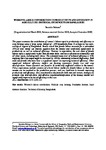Women’s Labour Contribution to Productivity and Efficiency in Agriculture: Empirical Evidence From Bangladesh
| dc.contributor.author | Rahman, S | |
| dc.date.accessioned | 2015-12-25T10:54:44Z | |
| dc.date.available | 2015-12-25T10:54:44Z | |
| dc.date.issued | 2010-06 | |
| dc.identifier.issn | 0021-857X | |
| dc.identifier.issn | 1477-9552 | |
| dc.identifier.uri | http://hdl.handle.net/10026.1/4017 | |
| dc.description.abstract |
<jats:title>Abstract</jats:title><jats:p> <jats:italic>This article examines the contribution of women’s labour input to productivity and efficiency in crop farming using a large survey dataset of 1,839 households from 16 villages in two agro‐ecological regions of Bangladesh. Results reveal that female labour accounts for a substantial 28% of total labour use (mainly supplied from the family) and contributes significantly to productivity as well as technical efficiency. Contrary to expectation, the cost share of female labour input is significantly higher than the male share, and has a substitution relationship with all other inputs, including male labour. The estimated mean level of technical efficiency is 0.90, implying that crop output might be increased by 10% by eliminating technical inefficiency. Both male and female education have a significant impact on improving technical efficiency. Other significant technical efficiency shifters are farming experience, family size and crop diversification. Owner operators are found to be technically inefficient relative to the tenants. Policy implications include creation of a hired labour market for female labour so that more women can be involved in the production process, and can contribute to towards improving productivity and efficiency. In addition, investment in education for both men and women, strategies to promote crop diversification and effective regulation/modification of the tenancy market will significantly improve technical efficiency in this case.</jats:italic> </jats:p> | |
| dc.format.extent | 318-342 | |
| dc.language | en | |
| dc.language.iso | en | |
| dc.publisher | Wiley | |
| dc.subject | Bangladesh | |
| dc.subject | input distance function | |
| dc.subject | multiple crop farming | |
| dc.subject | stochastic frontier | |
| dc.subject | technical efficiency | |
| dc.subject | women's labour contribution | |
| dc.subject | O33 | |
| dc.subject | Q18 | |
| dc.subject | C21 | |
| dc.title | Women’s Labour Contribution to Productivity and Efficiency in Agriculture: Empirical Evidence From Bangladesh | |
| dc.type | journal-article | |
| dc.type | Article | |
| plymouth.author-url | https://www.webofscience.com/api/gateway?GWVersion=2&SrcApp=PARTNER_APP&SrcAuth=LinksAMR&KeyUT=WOS:000277693800007&DestLinkType=FullRecord&DestApp=ALL_WOS&UsrCustomerID=11bb513d99f797142bcfeffcc58ea008 | |
| plymouth.issue | 2 | |
| plymouth.volume | 61 | |
| plymouth.publication-status | Published | |
| plymouth.journal | Journal of Agricultural Economics | |
| dc.identifier.doi | 10.1111/j.1477-9552.2010.00243.x | |
| plymouth.organisational-group | /Plymouth | |
| plymouth.organisational-group | /Plymouth/Faculty of Arts, Humanities and Business | |
| plymouth.organisational-group | /Plymouth/Users by role | |
| dc.identifier.eissn | 1477-9552 | |
| dc.rights.embargoperiod | Not known | |
| rioxxterms.versionofrecord | 10.1111/j.1477-9552.2010.00243.x | |
| rioxxterms.licenseref.uri | http://www.rioxx.net/licenses/all-rights-reserved | |
| rioxxterms.type | Journal Article/Review |


